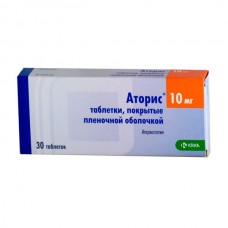Expiration date: 06/2026
The composition and form of issue:
Tablets, film-coated. 1 tablet contains:
atorvastatin calcium of 10.36 mg
Of 20.72 mg
(equivalent to 10 or 20 mg of atorvastatin, respectively)
excipients: povidone, sodium lauryl sulfate calcium carbonate MCC lactose monohydrate croscarmellose sodium magnesium stearate
the shell: Opadry II HP white 85F28751 (ingredients blockhouses substance Opadry II HP white 85F28751: polyvinyl alcohol, titanium dioxide (E171), macrogol 3000 and talc)
blistere in 10 PCs in a pack a cardboard 1, 3 or 9 blisters.
Tablets, film-coated. 1 tablet contains:
atorvastatin calcium 41,44 mg
(equivalent to 40 mg atorvastatin)
excipients: povidone, sodium lauryl sulfate calcium carbonate MCC lactose monohydrate croscarmellose sodium crospovidone magnesium stearate
the shell: Opadry White Y-1-7000 — hypromellose, titanium dioxide (E171), macrogol 400
blistere in 10 PCs in a pack a cardboard 1, 3 or 9 blisters.
Description pharmaceutical form:
Tablets 10 or 20 mg: round, slightly biconvex, film-coated white color. Kind of on a break-white mass with rough surface.
Pills 40 mg: round, slightly biconvex, film-coated white or almost white.
Pharmacokinetics:
The absorption of atorvastatin high, about 80% absorbed from the gastrointestinal tract. The time of occurrence of Cmax on average 1-2 hours in women Cmax above 20%, and the AUC lower for 10%. In patients with alcoholic cirrhosis of liver Tmax is 16 times higher than normal. Due to intensive metabolism at the first passage through the liver bioavailability of atorvastatin low (12%).
The average volume of distribution of atorvastatin is equal to 381 L. More than 98% of atorvastatin is associated with blood plasma proteins. Atorvastatin does not cross the BBB. Predominantly metabolized in the liver by cytochrome P450 3A4, with the formation of pharmacologically active metabolites (ortho - and parahydroxylated metabolites, the products of beta-oxidation). It's active metabolites, which cause approximately 70% of inhibitory activity for HMG-COA reductase, which persists for 20-30 h.
T1/2 of atorvastatin is 14 hours write mainly jelchew (not subject to pronounced enterohepatic recirculation, is not displayed during hemodialysis). Approximately 46% of atorvastatin is excreted through the intestine and less than 2% in the kidneys.
Description pharmacological action:
Atorvastatin — a lipid lowering drug from the group of statins. The major mechanism of action of atorvastatin is the inhibition of the activity of 3-hydroxy-3-methylglutaryl-And coenzyme - a (HMG-COA) reductase — the enzyme, catalysing the transformation g-Koa in mevalonova acid. This transformation is one of the earliest stages in the chain of cholesterol synthesis in the body. Suppression of atorvastatin the synthesis of cholesterol leads to increased reactivity of the LDL receptors in the liver and in extrahepatic tissues. These receptors bind LDL particles and remove them from the blood plasma, which leads to a reduction of LDL cholesterol in the blood.
Anti-atherosclerotic effect of atorvastatin is a consequence of the impact of the drug on the walls of blood vessels and blood components. The drug inhibits the synthesis of isoprenoids, which are factors of cell growth of the inner lining of blood vessels. Under the action of atorvastatin improves endotelinzawisimogo vasodilation. Atorvastatin lowers cholesterol, LDL, apolipoprotein b, triglycerides. Causes an increase in the content of HDL cholesterol and apolipoprotein A. Atorvastatin increases serum levels of HS-LPWN and reduces the values of the ratios of Cholesterol-LDL / HDL-C and total cholesterol / HDL-C. The drug is appointed in case of insufficient efficacy of diet therapy and other non-pharmacological methods of treatment.
As a rule, the action of Atoria develops after 2 weeks of taking the drug, and the maximum effect is achieved within 4 weeks.
Indications:
- To reduce the serum levels of total cholesterol, Cholesterol-LDL, apolipoprotein b and triglycerides in patients with primary hyperlipidemia (types IIA and IIb according to Frederickson) family heterozygous hypercholesterolemia mixed hyperlipidemia
- to reduce in plasma elevated levels of total cholesterol, Cholesterol-LDL and apolipoprotein b In patients with homozygous familial hypercholesterolemia.
Contraindications:
- hypersensitivity to any component of the drug
- liver disease in the active stage (including chronic active hepatitis, chronic alcoholic hepatitis)
- liver failure
- liver cirrhosis of any etiology
- the increase in liver transaminaz ambiguous Genesis
- diseases of skeletal muscle
- pregnancy and lactation, as well as the use in women of reproductive age not using adequate contraceptive methods
- the age of 18 years (efficacy and safety not established)
- galactosemia (because the drug contains lactose) or malabsorption syndrome glucose/galactose, lactase deficiency.
With caution:
- alcoholism
- liver disease in anamnesis.
Application of pregnancy and breast-feeding:
Atorvastatin is contraindicated in pregnant and nursing mothers. The drug is prescribed to women of childbearing age only if the probability of pregnancy they have very low, and the patient informed about the possible risk to the fetus. Women of reproductive age during treatment should use adequate methods of contraception.
If necessary, the appointment of Atoris should solve the issue of termination of breastfeeding.
Side effects:
CNS and peripheral nervous system: headache, dizziness, asthenic syndrome, insomnia or drowsiness, nightmares, amnesia, paresthesia, peripheral neuropathy, emotional lability, ataxia, hyperkinesis, depression, hypesthesia, weakness, malaise.
From the sensory organs: amblyopia, ringing in the ears, dryness of the conjunctiva, violation ccomodation, bleeding in the eye, deafness, glaucoma, parosmia, loss of taste sensations.
From the side of cardiovascular system: heartbeat, vasodilation, migraine, postural hypotension, the AD, phlebitis, arrhythmia, chest pain, vasculitis.
With the hematopoietic system: anemia, lymphadenopathy, thrombocytopenia.
The respiratory system: bronchitis, rhinitis, dyspnea, asthma, epistaxis.
From the digestive system: nausea, heartburn, constipation or diarrhea, flatulence, gastralgia, abdominal pain, anorexia or increased appetite, dry mouth, burp, dysphagia, vomiting, stomatitis, esophagitis, glossitis, gastroenteritis, hepatitis, hepatic colic, cheilitis, duodenal ulcer, pancreatitis, cholestatic jaundice, increased liver enzymes, rectal bleeding, melena, bleeding gums, tenesmus.
From the musculoskeletal: arthritis, muscle cramps feet, bursitis, myopathy, arthralgia, muscle weakness, rhabdomyolysis, joint contractures, rheumatic polymyalgia, myositis, back pain.
From the urogenital system: urogenital infections, dysuria (W. pollakiuria, nocturia, incontinence or urinary retention, urgent need to urinate), cystitis, hematuria, vaginal bleeding, uterine bleeding, urolithiasis, metrorrhagia, epididymitis, decreased libido, impotence, violation of ejaculation.
With the skin: alopecia, sweating, eczema, seborrhea, ekhimozy.
Allergic reactions: skin itching, skin rash, contact dermatitis rarely urticaria, angioedema, facial edema, lupus-like syndrome, vasculitis, photosensitivity, anaphylaxis, erythema multiforme exudative, Stevens-Johnson syndrome, toxic epidermal necrolysis (Lyell's syndrome).
The laboratory parameters: hyperglycemia, hypoglycemia, increased serum CPK, albuminuria, increased ALT activity, AST, thrombocytopenia, eosinophilia, increase of erythrocyte sedimentation rate (ESR).
Other: peripheral edema, weight gain, gynecomastia, the worsening gout, fever.
Drug interactions:
Coadministration of atorvastatin with cyclosporine, antibiotics (erythromycin, clarithromycin, quinupristin/dalfopristin), HIV protease inhibitors (indinavir, ritonavir), antifungals (fluconazole, Itraconazole, ketoconazole), or nefazodone may lead to elevated levels of atorvastatin in the blood serum, which increases the risk of myopathy with rhabdomyolysis and kidney failure. A similar interaction is possible with the combined reception of Atoria with fibroevoy acid derivatives (fibrates) and Niacin (nicotinic acid).
Simultaneous reception of atorvastatin with phenytoin may reduce the effectiveness of atorvastatin. When co-administered antacids (suspension of hydroxides of magnesium and aluminium) reduce the amount of atorvastatin in the blood plasma.
While admission of atorvastatin with colestipol atorvastatin concentration in plasma is reduced by 25%, but the therapeutic effect of the combination is higher than the effect of one of atorvastatin.
The simultaneous use of drugs, reducing the concentration of endogenous steroid hormones (W. cimetidine, ketoconazole, spironolactone), increases the risk of reduction of endogenous steroid hormones (caution must be exercised).
For patients receiving both 80 mg atorvastatin and digoxin, of digoxin in plasma increases by about 20%. Patients receiving atorvastatin and digoxin, should be observed.
During simultaneous administration of atorvastatin and oral contraceptives (norethindrone and ethinyl estradiol) may increase the absorption of contraceptives and the increase of their concentration in blood plasma. You should control the choice of contraceptives among women, receiving atorvastatin.
Simultaneous reception of atorvastatin with warfarin may increase in the first days of action of warfarin on coagulation parameters of blood (decrease in RO). This effect disappears after 15 days of co-administration of these drugs.
Cimetidine is clinically significant interaction no.
Concomitant use with protease inhibitors increases the concentration of atorvastatin in plasma.
The consumption of grapefruit juice during treatment with Torison may lead to higher concentration of the drug in the blood plasma. In this regard, the patients taking Atoris should avoid drinking this juice.
Method of application and dose:
Before starting treatment with Atricom the patient should be transferred to lipid-lowering diet which should be observed during drug therapy.
Inside, regardless of meals, once (at any time of the day, but at the same time), every day.
The recommended starting dose is 10 mg daily. Depending on the desired effect, the daily dose may be increased to 80 mg.
Therapeutic effect of Atoris develops within 2 weeks of taking the drug, and the maximum effect is achieved within 4 weeks. Therefore, the dose should not be changed earlier than 4 weeks after the start of treatment.
When primary (heterozygous hereditary and polygenetic) NCEP (type IIA) and mixed hyperlipidemia (type IIb) treatment starts with an initial dose of 10 mg 1 time per day, that increase through 4 weeks depending on patient response. The maximum daily dose — 80 mg.
In homozygous familial hypercholesterolemia, the initial dose selected individually, depending on the severity of the disease. When using the maximum daily dose of 80 mg (once) showed the optimal effect.
Atoris used as a complementary therapy to other therapies (plasmapheresis) or as a primary treatment, if treatment by other methods is impossible.
For elderly patients, as well as diseases of the kidney dose adjustment is not required.
Patients with human liver the drug is prescribed with caution in connection with the slowing removing it from the body. In this situation it is necessary to control clinical and laboratory parameters, and identifying a substantial pathological changes of dose should be reduced or treatment should be discontinued.
Overdose:
Symptoms: in the development of myo with rhabdomyolysis and subsequent acute renal failure (rare but severe side effect) the drug must be immediately cancelled.
Treatment: the patient must enter a diuretic and a solution of sodium bicarbonate. If necessary to carry out hemodialysis. Rhabdomyolysis can cause hyperkalemia which elimination requires intravenous administration of calcium chloride or calcium gluconate, infusion of glucose with insulin, the use of the exchange of potassium ions or, in severe cases, hemodialysis. Because atorvastatin is largely associated with blood plasma proteins, hemodialysis is a relatively inefficient way to remove this substance from the body.
General activities: monitoring and maintaining vital functions and prevent further absorption of the drug (gastric lavage, the appointment activated carbon or laxatives).
Special instructions:
Before therapy the patient Atricom you want to assign a standard cholesterol-lowering diet, which he must observe during the entire treatment period.
Increased activity of liver enzymes in the serum may occur during treatment with Atricom. This increase is usually small and has no clinical significance. However, we recommend monitoring liver enzymes in the blood serum before treatment, after 6 and 12 weeks, and with increasing doses of atorvastatin. If there is a three-fold relative to the upper limit of normal increase in activity ACT and/or ALT, treatment with Torison should be discontinued. Atorvastatin may cause an increase in the activity of creatine kinase and transaminases.
In women of reproductive age not using reliable contraception, the use of Atoria is not recommended. If the patient is planning pregnancy, she should stop taking Atoris, at least a month before a planned pregnancy.
Treatment Atricom may cause myopathy, which is sometimes accompanied by rhabdomyolysis leading to acute renal failure. The risk of this complication increases at simultaneous reception with Torison one or more of the following drugs: fibroevoy acid derivatives, Niacin, cyclosporine, nefazodone, certain antibiotics, antifungal agents from the group of azoles, inhibitors of HIV protease.
Effects on ability to drive and operate machinery. Regarding the adverse impact of Atoris on the ability to drive and work with mechanisms not reported.







